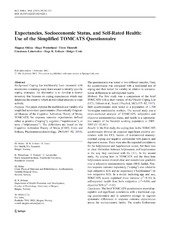| dc.contributor.author | Odeen, Magnus | |
| dc.contributor.author | Westerlund, Hugo | |
| dc.contributor.author | Theorell, Töres | |
| dc.contributor.author | Leineweber, Constance | |
| dc.contributor.author | Eriksen, Hege Randi | |
| dc.contributor.author | Ursin, Holger | |
| dc.date.accessioned | 2016-06-07T10:56:07Z | |
| dc.date.available | 2016-06-07T10:56:07Z | |
| dc.date.issued | 2013-06 | |
| dc.identifier.issn | 1070-5503 | |
| dc.identifier.issn | 1532-7558 | |
| dc.identifier.uri | https://hdl.handle.net/1956/12074 | |
| dc.description.abstract | Background: Coping has traditionally been measured with inventories containing many items meant to identify specific coping strategies. An alternative is to develop a shorter inventory that focusses on coping expectancies which may determine the extent to which an individual attempts to cope actively. Purpose: This paper explores the usefulness and validity of a simplified seven-item questionnaire (Theoretically Originated Measure of the Cognitive Activation Theory of Stress, TOMCATS) for response outcome expectancies defined either as positive (“coping”), negative (“hopelessness”), or none (“helplessness”). The definitions are based on the Cognitive Activation Theory of Stress (CATS; Ursin and Eriksen, Psychoneuroendocrinology, 29(5):567–92, 2004). The questionnaire was tested in two different samples. First, the questionnaire was compared with a traditional test of coping and then tested for validity in relation to socioeconomic differences in self-reported health. Methods: The first study was a comparison of the brief TOMCATS with a short version of the Utrecht Coping List (UCL; Eriksen et al., Scand J Psychol, 38(3):175–82, 1997). Both questionnaires were tested in a population of 1,704 Norwegian municipality workers. The second study was a cross-sectional analysis of TOMCATS, subjective and objective socioeconomic status, and health in a representative sample of the Swedish working population in 2003– 2005 (N011,441). Results: In the first study, the coping item in the TOMCATS questionnaire showed an expected significant positive correlation with the UCL factors of instrumental masteryoriented coping and negative correlations with passive and depressive scores. There were also the expected correlations for the helplessness and hopelessness scores, but there was no clear distinction between helplessness and hopelessness in the way they correlated with the UCL. In the second study, the coping item in TOMCATS and the three-item helplessness scores showed clear and monotonous gradients over a subjective socioeconomic status (SES) ladder. Positive response outcome expectancy (“coping”) was related to high subjective SES and no expectancy (“helplessness”) to low subjective SES. In a model including age and sex, TOMCATS scores explained more variance (r200.16) in self-reported health than both subjective (r200.08) and objective SES (r200.02). Conclusion: The brief TOMCATS questionnaire showed acceptable and significant correlations with a traditional coping questionnaire and is sensitive enough to register systematic differences in response outcome expectancies across the socioeconomic ladder. The results furthermore confirm that psychological and learning factors contribute to the socioeconomic gradient in health. | en_US |
| dc.language.iso | eng | eng |
| dc.publisher | Springer | eng |
| dc.relation.ispartof | <a href="http://hdl.handle.net/1956/12078" target="blank">Coping at Work. The role of knowledge and coping expectancies in health and sick leave</a> | |
| dc.rights | Attribution CC BY | eng |
| dc.rights.uri | http://creativecommons.org/licenses/by/3.0/ | eng |
| dc.subject | Cognitive Activation Theory of Stress (CATS) | eng |
| dc.subject | Socioeconomic gradient in health | eng |
| dc.subject | TOMCATS inventory | eng |
| dc.subject | Coping | eng |
| dc.subject | SES ladder | eng |
| dc.title | Expectancies, Socioeconomic Status, and Self-Rated Health: Use of the Simplified TOMCATS Questionnaire | eng |
| dc.type | Peer reviewed | |
| dc.type | Journal article | |
| dc.description.version | publishedVersion | |
| dc.rights.holder | Copyright The Author(s) 2012 | eng |
| dc.identifier.doi | https://doi.org/10.1007/s12529-012-9221-x | |
| dc.identifier.cristin | 1039696 | |
| dc.source.journal | International Journal of Behavioral Medicine | |
| dc.source.40 | 20 | |
| dc.source.14 | 2 | |
| dc.source.pagenumber | 242-251 | |

